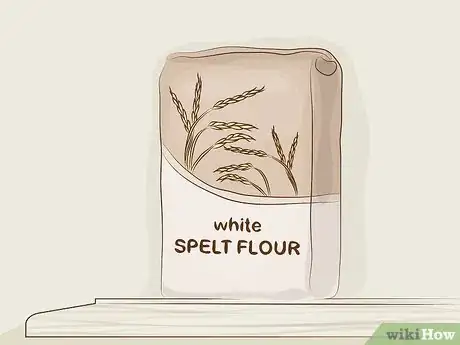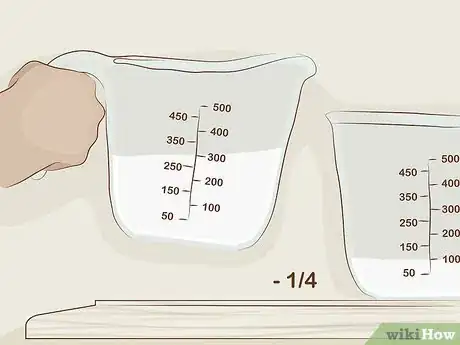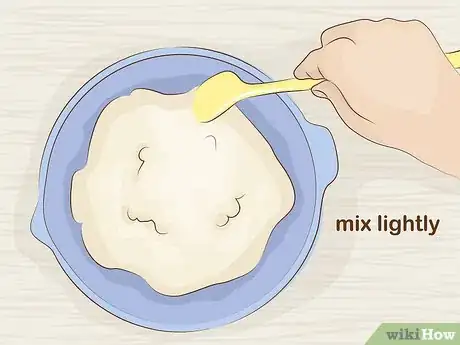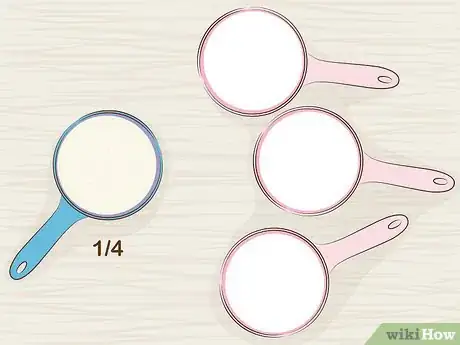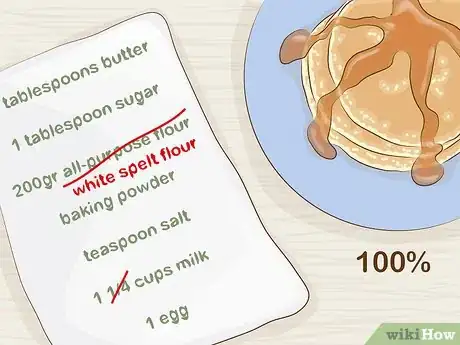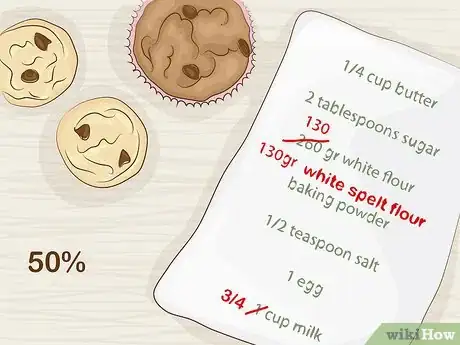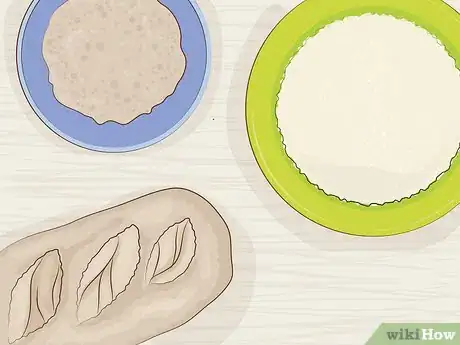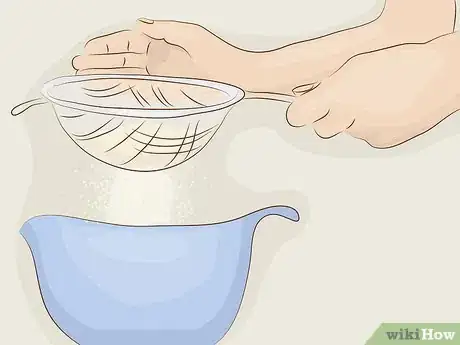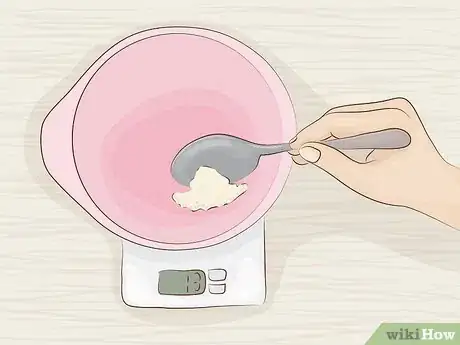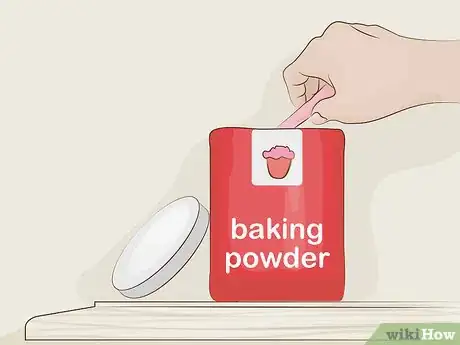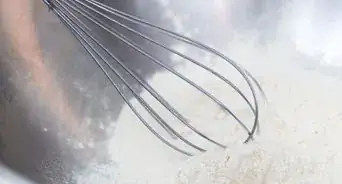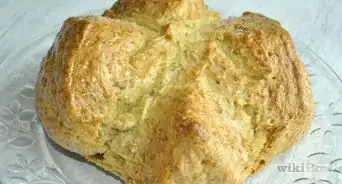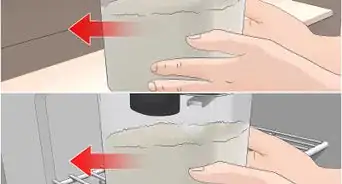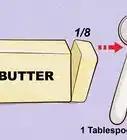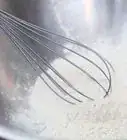This article was co-authored by wikiHow Staff. Our trained team of editors and researchers validate articles for accuracy and comprehensiveness. wikiHow's Content Management Team carefully monitors the work from our editorial staff to ensure that each article is backed by trusted research and meets our high quality standards.
wikiHow marks an article as reader-approved once it receives enough positive feedback. In this case, 89% of readers who voted found the article helpful, earning it our reader-approved status.
This article has been viewed 117,274 times.
Learn more...
Most traditional baking recipes call for all-purpose flour to provide structure to cookies, cakes, breads, and other baked goods. If you have a wheat allergy or sensitivity, though, all-purpose flour is off limits. Spelt flour is an ideal alternative because it is wheat-free and has a delicious, nutty flavor. However, substituting spelt for all-purpose flour requires adjusting your recipe just a bit so you get the same moist texture and structure for your baked goods that you would with all-purpose flour.
Steps
Making the Basic Substitution
-
1Use white spelt flour instead of all-purpose flour. Spelt flour is available in two varieties: white and whole. White spelt flour has the bran and germ removed so it will provide a lighter texture in baked goods. As a result, it’s the best substitute for all-purpose flour in your favorite recipes.[1]
- You can usually find white spelt flour at natural food stores and the organic section of traditional grocery stores.
-
2Reduce liquids by ¼. Spelt flour is more water soluble than all-purpose flour. That means you don’t need to mix as much liquid into your recipes if you’re substituting spelt. Reducing the amount of liquid ingredients in the recipe by ¼ usually provides the best results.[2]
- If you’re making a recipe with a liquid that’s hard to reduce, you can increase the amount of flour than you use instead. For example, if you need to add whole eggs, increase the spelt flour by 10 to 15% instead of reducing the amount of the eggs.
Advertisement -
3Mix the dough or batter lightly. The gluten in spelt flour is different than the gluten in all-purpose flour, so it’s important to handle the dough or batter you make with it accordingly. All-purpose flour can be kneaded or mixed for a long time, but if you overmix spelt batters or doughs, you can wind up with crumbly baked goods. Knead or mix until the dough or batter is just combined.[3]
Adjusting the Amounts
-
1Start with just ¼ spelt flour to test. When you’re beginning to experiment with spelt flour substitution, it’s best to ease your way into it. Replace just ¼ of the all-purpose flour in your recipe with spelt and use all-purpose flour for the remaining ¾ to see how the finished product turns out. You can gradually begin to increase the amount of spelt when you know how it will affect the recipe.
- If you’re only using ¼ spelt flour for a recipe, you don’t necessarily have to reduce the amount of liquid. See how the final product turns out before deciding if you have to adjust the liquids.
-
2Use 100% spelt flour for pancakes. For pancakes, you can make a 1 for 1 substitution with spelt and all-purpose flour. The spelt will give the pancakes a rich, sweet whole wheat flavor, while still creating a moist, fluffy texture.
- If you’re doing a 1 for 1 substitution with spelt in your pancakes, be sure to reduce the liquids by ¼.
-
3Use half spelt and half all-purpose for cookies, muffins, and breads. With baked goods like cookies, muffins, or sweetbreads, having a moist, soft texture is important. Instead of using a 1 for 1 substitution with spelt and all-purpose flour, you’re better off using half spelt and half all-purpose. That will keep them from being too crumbly.
- It usually isn't necessary to reduce the liquid in a recipe if you're using half spelt and half all-purpose flour.
-
4Opt for 50% spelt flour with yeast breads. If you’re making a delicious yeast bread, using all spelt flour in place of all-purpose can lead to dry bread that has a pronounced whole wheat flavor. Using half spelt flour instead keeps the bread moist and provides a sweet, mild flavor.
- You don't have to reduce the liquid if you're only using 50% spelt flour in your yeast bread recipe.
Getting the Best Results
-
1Sift spelt flour. White spelt flour is less refined than whole spelt. As a result, it’s a good idea to sift it before mixing it into your recipes as a substitution for all-purpose flour. That will help break up any lumps and remove any chunks of bran.[4]
-
2Weigh spelt flour for accurate measurements. Spelt flour often weighs differently than all-purpose flour, so using a cup of spelt may not necessarily weigh the same as all-purpose. To be sure that you get the proper amounts, weigh the spelt flour on a food scale before adding it to a recipe.
- 1 cup of white spelt flour contains 102 grams, while 1 cup of all-purpose flour contains 125 grams.
-
3Add baking powder for self raising flour. Spelt flour doesn’t allow baked goods to rise all that much. If you are replacing self-rising all purpose flour in recipe, mix in ¾ teaspoon (3 g) of baking powder for every cup (102 g) of spelt flour that you’re using to get a good rise.[5]
Community Q&A
-
QuestionCan all-purpose flour be substituted for spelt flour?
 Community AnswerYes, you can do that as well.
Community AnswerYes, you can do that as well. -
QuestionMy bread recipe calls for eight cups of all purpose flour, but I only have six. Can I use two cups of spelt flour to make up the difference?
 Ann HupeCommunity AnswerYes. This fits the 25 percent formula for baked goods. A higher substitution percentage is allowed for things like crusts.
Ann HupeCommunity AnswerYes. This fits the 25 percent formula for baked goods. A higher substitution percentage is allowed for things like crusts. -
QuestionHow to substitute whole spelt all purpose flour for wheat flour?
 Spaceworld298Community AnswerWhile it's great for hearty breads and muffins, it may not be the best choice for cakes and other light pastries. Don't forget to add a leavening agent if you're using plain whole-wheat flour in place of self-rising flour. Whole-wheat flour is a whole-grain substitute for self-rising flour.
Spaceworld298Community AnswerWhile it's great for hearty breads and muffins, it may not be the best choice for cakes and other light pastries. Don't forget to add a leavening agent if you're using plain whole-wheat flour in place of self-rising flour. Whole-wheat flour is a whole-grain substitute for self-rising flour.
References
- ↑ https://whatscookingamerica.net/CharlotteBradley/Spelt-Flour.htm
- ↑ http://www.onegreenplanet.org/vegan-food/tips-for-baking-with-spelt-flour/
- ↑ http://bakingbites.com/2008/04/what-is-spelt-flour/
- ↑ http://bake-with-spelt.com/PDF/Baking_with_Spelt_Tips_and_Recipes.pdf
- ↑ http://bake-with-spelt.com/PDF/Baking_with_Spelt_Tips_and_Recipes.pdf
About This Article
If you want to use spelt flour instead of all-purpose flour, replace 1/4 of your regular flour with spelt to start and slowly increase this amount as you get used to the new flour. Since spelt is more water soluble than all-purpose flour, make sure to also reduce the amount of liquid ingredients in the recipe by ¼ or increase the amount of spelt flour by 10-15%. Finally, the gluten in spelt flour reacts differently than in other types of flour, so don't overmix the batter or else you will wind up with crumbly baked goods. If you want to learn how to mix flour ratios for certain recipes, like for pancakes or cookies, keep reading the article!
